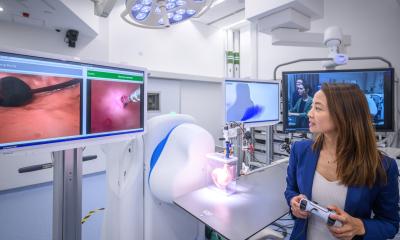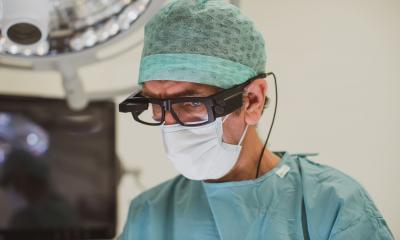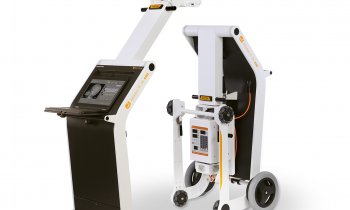Source: Shutterstock/jamesteohart
Article • Mobile data transfer
5G makes tele-surgery fit for the future
A 4G symbol next to the signal strength bar on a smartphone assures fast data transmission. 5G, the next generation of technology, is already waiting in the wings and could herald a new era for tele-surgery, PD Dr. Michael Kranzfelder is convinced. However, there are a few obstacles to overcome first.
Report: Wolfgang Behrends
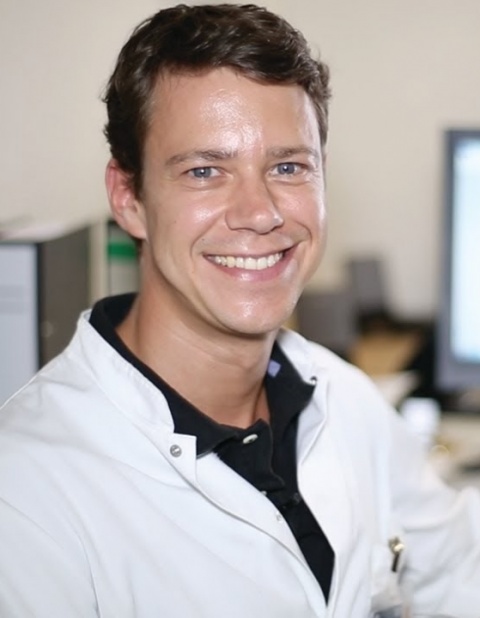
Whilst 4G has data transfer speeds of up to 100 Mbit/s, 5G will increase this to 10Gbit/s, i.e. a hundredfold, explained the Senior Physician of the Clinic and Policlinic for Surgery at the Rechts der Isar Hospital, Technical University of Munich, during this year’s Congress of the German Society of Surgery in Berlin. “It will open up many new areas of application for which the previous mobile data transmission standard was simply not fast enough.” This is important for the development of virtual and augmented reality as much as for autonomous driving, the use of professional drones and robots as well as for tele-surgery.
Although 4G should be sufficient for real-time transmission of high-resolution video images (such as HDTV) under ideal conditions, in reality, the data transfer speed is often lower or limited by latency. The latter phenomenon has been a particular problem for the use of mobile data connections in surgery as each delay represents a risk to the patient. The 5G standard which is due to be introduced in 2019/2020 promises a reduction of latency by a factor of 10, to around one millisecond – bringing use in the operating theatre within tangible reach.
Mobile data connection facilitates medical care in rural and remote locations
5G could facilitate intelligent, real-time tracking of people and objects
Michael Kranzfelder
“For the first time, the speed and latency of 5G are now meeting the requirements of tele-presence and even tele-surgery,” explains Kranzfelder. In contrast to passive tele-consultation, the surgeon can actively intervene in the treatment. “One example of this is remote control of a camera guide arm which moves the laparoscope during minimally-invasive interventions.” This requires real-time transfer not only for remote control but also for the video signal so that the surgeon is immediately aware of the effects of his actions without delay and can react at once. The model would also be suitable for the substantial improvement of surgical care in remote locations as specialists from anywhere could be involved in almost all locations all over the world.
The fast mobile data standard also opens up new opportunities for process optimisation in the operating theatre: “5G could facilitate intelligent, real-time tracking of people and objects – the so-called track & trace,” says Kranzfelder. The evaluation of such data can lead to improvements of the operative workflow, helping to avoid for example unnecessary work and moves in the operating theatre. The surgeon also sees the potential of this technology for training: Real-time overlay of helpful markers during an intervention could focus the surgeon’s attention towards important structures.
The course is being set now
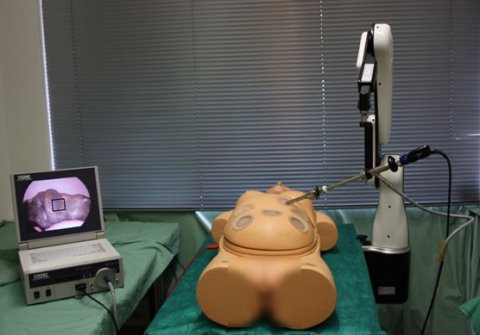
To test the opportunities and limitations of the new technology, researchers at the Technical University of Munich have equipped a test operating-theatre with prototypes of 5G-capable access points and terminals. Using this set-up, they checked whether control commands can be transmitted to robots and processed fast and reliably, and whether endoscopic image data can be viewed without delay.
Kranzfelder believes that results obtained so far are encouraging: “5G is a trend-setting technology which will play an important role in surgery. However, whether or not it will make the wireless operating theatre a reality remains to be seen.” It is also not yet clear whether vulnerability to failure during large-scale use is likely to increase. The objective should therefore be to become actively involved in shaping the standardisation process to ensure that the data standard meets the requirements of surgery upon its introduction to the market. “This is a very critical area of application, and it is likely to be regarded with the same critical eye as autonomous driving is at the moment,” emphasises the expert.
Profile:
PD Dr. Michael Kranzfelder is a specialist for general surgery at the Rechts der Isar Hospital, Technical University of Munich in Germany. There, he is part of the research group for minimally-invasive therapeutic interventions (MITI). His research focuses on the implementation of intelligent, cooperative OR systems, sensor-based real-time workflow analysis and prediction, radio-frequency identification (RFID) and navigated diagnostics in ultrasound and endoscopy.
11.11.2018



